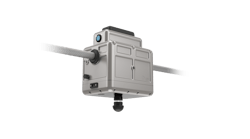An evaluation conducted at the Electric Power Research Institute confirmed that Utility Risk Management Corp.'s new thermal sensor, Thermal Direct, can accurately measure transmission line temperatures across a broad spectrum of conductors and field conditions.
The completion of this third-party, blind test establishes that conductor temperature needs no longer be estimated. With this technology the industry and consumers will benefit from more precise capacity definition. The technology is transparent, accurate and timeless.
During controlled outdoor testing at EPRI’s High-Voltage Laboratory in Lenox, Massachusetts, Thermal Direct measurements were compared to EPRI line monitors. Thermal Direct was able to measure the conductor temperature with an error of less than 5°C over a range of conditions typical for operating transmission lines. All EPRI and URMC measurements were kept separated until the completion of each test series, and the results do not represent an EPRI endorsement of Thermal Direct.
Dale Douglass, principal engineer at Power Delivery Consultants, who witnessed the tests, noted that the direct measurement of conductor temperature can eliminate the need for subsequent clearance checks of questionable spans by ground survey crews. He also noted that direct measurement of conductor temperature at multiple points between dead-end structures should lead to more accurate high-temperature sag calculations with numerical line design programs such as PLS-CADD.
"The fact that Thermal Direct measurements of conductor temperature were either equal to or slightly less than EPRI measurements is encouraging as it will result in a mildly conservative estimate of line clearance at maximum temperature," Douglass said. ¯Thermal Direct appears to be a viable alternative to more complex calculation methods that require precise measurement of weather conditions and knowledge of line current at the time of the survey."
The scientific tests assessed the impact of various factors, including: conductor emissivity, conductor temperature, conductor size, and local environmental conditions. Using Thermal Direct equipment mounted to a helicopter, URMC scanned sample spans, representing a wide variety of conductor types and provided temperature readings by time, span and probe. The conductor temperatures were established by controlling the current through the conductor. The circuits flown were monitored at discrete points by EPRI temperature sensors attached to the conductors. A more thorough analysis and documentation process is underway, and will be reported by EPRI in the future.
As overhead transmission lines age and sag, they must be designed and operated to assure public safety while undergoing a wide range of power flows and environmental conditions. The ability of Thermal Direct to accurately measure line temperatures will assist utilities with the conservative, long-term approach required for grid reliability and efficiency.

